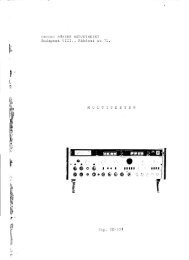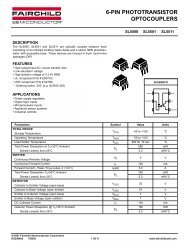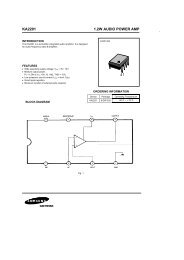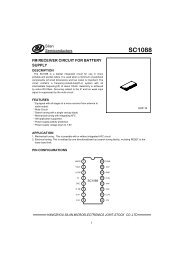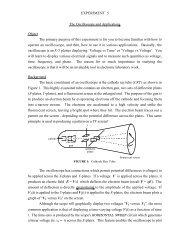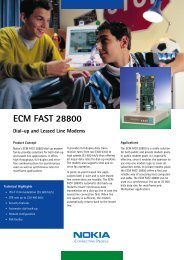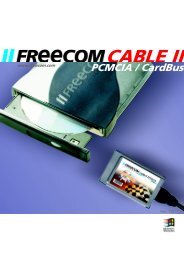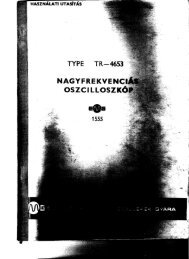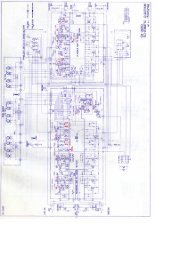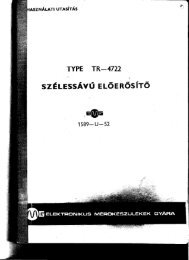Quad 33 manual - n-1
Quad 33 manual - n-1
Quad 33 manual - n-1
- No tags were found...
You also want an ePaper? Increase the reach of your titles
YUMPU automatically turns print PDFs into web optimized ePapers that Google loves.
ContentsIntroductionInstallationMounting the unitsConnectionsPickup (Disc) AdaPtor ...Tape AdaptorInitial Checks and OPeretionControlsLoudspeaker phasingLoudspeaker positionOperation SummaryServiceSpecificationsGuaranteePage2J4&56to107l01313 to 15l5I7l818l9 to 2324lllustrationsPageInstallation Schematic 3Pickup and motor wiringMounting the <strong>Quad</strong> <strong>33</strong>4Connections to <strong>Quad</strong> 3035DIN plugs6DISC input7Disc Adaptor Board8Tape and Radio inputs8Tape Adaptor Board9Tape Adaptor adjustments10<strong>Quad</strong> <strong>33</strong> rear panel laYout1l<strong>Quad</strong> <strong>33</strong> controlsl2<strong>Quad</strong> <strong>33</strong> performance curvesl6<strong>Quad</strong> 303 performance curves23THE ACOUSTICAL MANUFACTURING CO. LTD.ST. PETERS ROAD, HUNTINGDON, ENGLANDTelephone: Huntingdon (0480) 2561Telegrams: Acoustical Huntingdonlssue 4/3m/271
QUADfor the closestapproach to theoriginal soundINTRODUCTIONThis amplifier has been designed to provide the bestpossible quality of reproduction but it must be bornein mind that the standard of performance of the completeequipment will be limited by that of the poorestlink in the chain. Thus, the gramophone motor, pickup,loudspeaker, etc., should all receive careful considerationif full advantage is to be taken of the capabilities of theamplifier.A complete installation is shown in Fig. I and thesamo basic arrangement will apply in whole or in part,whatever associated equipment is used with the <strong>Quad</strong><strong>33</strong>. Installation is quite straightforward and shouldpresent no difficulty to the intelligent enthusiast providedthe following notes are observed.Please note that three printed circuit boards from the<strong>Quad</strong> <strong>33</strong> are packed separately for safe transit. Thesemust be inserted during installation. See Fig. 3 andalso instructions contained in the packing.I tPage Two
INSTALLATIONNormally equipment of this type may be eithermounted in a wide varietry of housings or used freestanding,and if you are designing your own layout itmight be advisable to assemble all the parts in a mockupform before deciding on the final arrangement, justto make sure there are no unforeseen difficulties ofoperation or inter-unit wiring, etc.Adequate ventilation must be provided for unitsproducing heat, including transistorised lx]wer amplifiersand if the latter are to be mounted closer than about12 inches from either control unit or tuner it might benec€ssary to experiment with orientation and positionto ensure that no hum is induced in the latter units.0lN plugtoDISC inputotO<strong>33</strong>FIG. 1Page Three
Close proximity of the control unit and tuners toeach other should cause no problem unless the controlunit is mounted immediately on top of the tuner, inwhich case a space of about two inches should be leftbetween them.Hum can also occur if a low output magnetic pickupis too close to a mains transformer or if its leads runclose to the mains wiring. (See Fig. 2).All metal parts must be earthed but, because multipleearth connections cause hum, they should be earthed,directly or indirectly, by one connection only, and thewhole installation earthed at one point such as the Eterminal on the rear of the control unit, OR the thirdpin of the control unit mains socket, but not both.(Note: All the <strong>Quad</strong> units are already bondedtogether by their own inter-connecting cables).Always follow the manufacturers' instructions suppliedwith pickup, motor, tape recorder, etc., and refer anyquery which may arise to your dealer or in case ofdifficulty to the manufacturer concerned.Lugs .CovsrLocatins Slid6FIG. 3PLUGIN BOAROS2 x M12017 M120lSI' (2Omm) tickt)OUAD <strong>33</strong>coverIf the <strong>Quad</strong> <strong>33</strong> is not to be used free standing youwill require an aperture lA' x 3" as shown in Fig. 3and a template is provided in the rear of this bookletto assist in marking this out on the cabinet. The coveris then removed from the <strong>Quad</strong> <strong>33</strong>, the unit p'assedthrough the aperture from the front so that its lugslocate in the aperture, and the cover replaced from therear, thus gripping the cabinet panel between the <strong>Quad</strong><strong>33</strong> front casting and its cover. The securing screwsshould be inserted finger tight and then given one furtherhalf-turn to lock the unit firmly in position.Page Four
The <strong>Quad</strong> 303 carries no controls and may bemounted out of sight inside the cabinet or at any otherconvenient position in the installation.The <strong>Quad</strong> 303 may be either stood on its feet on ashelf or base board of a cabinet, or more securely fixedby drilling four holes in the shelf or board to coincidewith the feet centres, removing the feet securing screwsand passing the longer screws provided, up through theseholes, through the feet which act as spac€rs to assistcirculation of air under the amplifier, and into thetapped bushes in the base-plate.Slots or holes should be cut in or near the base andin or near the top of any enclosed compartment topermit a flow of air upwards through the compartment,past and through the amplifier to assist ventilation. Inconfined spaces where the exit vents are not directlyover the amplifier a deflector plate of plywood orasbestos may be mounted at an inclined angle above theamplifier to help guide the rising warm air towards theexit vent and prevent an accumulation of warm airunder a closed horizontal top.Page Five
CONNECTIONSDin styls plugs showing method of assembly. See individual illustrationsfor Din connections.Control Unit to Power AmplifierTwo leads are supplied with the control unit. Thatwith a 4-pin connector at each end is reversible andconnects the control unit output to the power amplifierinput. The other connects the switched mains supplyfrom the control unit to the power amplifier and the2-pin plug at the control unit end of this lead isreversible. (See Fig. l0). Longer leads are permissiblewhere required for special installations (see Specificationon page 2l).Power Amplifier to LoudspeakersOrdinary lighting flex or similar cable may be usedfor connecting the loudspeakers to the power amplifierunless a very long run is involved in which case a heaviercalibre cable should be used. As a rough guide the DCresistance of the cable should not exceed about 5,% ofthe nominal impedance of the loudspeaker. Each loudspeakershould be connected to its appropriate lloweramplifier output so that the two pairs of wires are connectedin the same way, to ensure that the speakersoperate in phase. For example, if the top output socketon one channel is connected to the left-hand terminalof its speaker, the top output socket on the otherchannel should also be connected to the left-handterminal of its speaker. This is quite straighfforwardbut should there be any doubt the phasing can bechecked later experimentally. (See Page l5). Whereone loudspeaker only is used for mono, phase is notimportant and in this case either outlet may be usedand the sockets of the other channel left vacant.In cases where loudspeakers, such as the electrostaticloudspeaker, also require an eneryising supply, the\Pape Six
input and an AM tuner for long distance reception toRadio 2. <strong>Quad</strong> self-powered tuners are supplied withthe correct connectors and may be plugged in immediately.The connectors used on other self-powered tunersshould be adapted as n€cessary and those already fittedDISC ADAPTOR BOARDuRldb I Tcpru'RrcoldtfS.Qlt,f,-,ScSbrt AgfSGT,?t-- euAD <strong>33</strong>Radio (See Fig. 7)Sockets are provided on the <strong>Quad</strong> <strong>33</strong> for two radiotuners to be connected. For example, an FM tuner,used for mono or stereo, may be connected to Radio IFIG. 7Page Eight
with the same type of plug should be checked to ensurethat the same connections are used. The output of suchtuners should be suitable for the <strong>Quad</strong> <strong>33</strong> input ofl00mV and l0OK ohms (stereo) or l00mV and50K ohms (mono).The mains supply for these tuners should also betaken from the mains outlet sockets at the rear of the<strong>Quad</strong> <strong>33</strong>. (See Fig. l0).WARNINGOn no account should the HT ILT lead of earlier <strong>Quad</strong> tunersbe connected to the power supplies sockets of the <strong>Quad</strong> <strong>33</strong>control unit. If such tuners are used a separute power packmust be provided.TapeThree essential functions are provided for taperecording:(l) to provide a signal of the right level for recording,not afiected by any of the tone, filter or volumecontrols and without afiecting normal listening;(2) to accept a signal of any likely level from the recorderfor replay and subject this to all theappropriate control facilities, andFIG. 8TAPE ADAPTOR BOARD(3) to monitor the signal off the tape during recordingwithout interrupting the recording operation, providing,of course, that the tape recorder has amonitor output.Page Nine
The plug-in Tape Adaptor Board provides threealternative signal level settings each for recording andreplay on both channels, by means of small screwsinserted from the underside of the board into the appropriateposition for the signal level of the tape recorderto be used. (See Fig. 9 and Specification on Pages 20and 2l').Scr€ws for adju$ing outpu!lrcm Ou6d <strong>33</strong>rotam r€coderL6fthandchannolIn$dthi6dgsinlo r€ar ofcontol UntrRigh! hand channclFIG. 9Normally either one or both tape sockets may be usedfor recording and replay as convenient the (L) and (R)pins (See Fig. 7) of the record socket being linked insidethe control unit to the corresponding pins of the replaysocket. Where the levels and impedances are such thatcross-talk can appear in the cables and connectors itwill be advisable to use completely separate connectionsfor recording and replay.Mains OutletsThese sockets are intended for supplying the <strong>Quad</strong>303 power amplifier and the FM stereo tuner. Normallyit will be more convenient to run the mains supply directto tape recorder and gramophone motor since theseincorporate their own on/off switching, but if otherunits are run off the <strong>Quad</strong> <strong>33</strong> mains outlets the totalcurrent drawn must not exceed 2 amps.Mains InputA 3-pin connector is provided for the control unitand this should be wired to the mains supply using asuitable grade of flexible cable. In countries where anearth connection is not used or where an external earthis connected to the E terminal of the control unit thethird pin of the plug should be left blank.Pape Ten
Combined record/replay socket.Any programme passing throughthe <strong>Quad</strong> <strong>33</strong> may be recordedwithout interrupting normal listen-Ing.Two switched AC Mains outletsfor supplying radio tuner andpower amplifierInput for stereo/mono radioAdditional inout fortape replay only.AC Mains input.IInput for stereo,/mono pickup.QIAD <strong>33</strong>Second radio. e.9., AM for longdistance reception, or Auxiliary input.Output to power amplifierEanh terminal.Plug-in printed circuit boardpermitting independent adjustmentof signal levels for bothrecording and replay on eachchannel.Plug-in printed circuit boardcanying pickup input circuit.This board may be inserted onany of its four edges to providefour alternative input matchings.Ftc. 10All signal connections comply with the intemationallyused DIN standads.Page Eleven
Volume control andon/off switchQUAD nameplate lights upwhen unit is switched onControl for adjustingbalance between channelsPress to select left-hand channeland upper track tape.Press to select right-hand channel and lower track tapePress both together for twochannel monoIIIlPress to select the input requiredPressing the Tape button whileanother input is selected alsoprovides AB monitoring facilityoff tap€ during recording: Pressto listen to tape: Release tolisten to original.Pressing the Cancel button overridesthe settings of bass, trebleand filter controls and provides avery uselul reference standardFilter Slope control, used in conjunctionwith the 5K, 7K and10K pushbuttons, removes recordsurface noise, high frequencydistortions, eic (seeperformance curves)I IIIlIPage TwelveFtG. t1
INITIAL CHECKS AND OPERATIONBefore connecting the mains supply, ensure that thevoltage marked on the rear of the control unit and thesetting of the selectors on the power amplifier and tunerare correct for your mains. These selectors are set bywithdrawing the cap $", rotating it to the requiredvoltage and pushing it fully home again. Then connectthe mains and rotate the volume cantrol to switch onthe equipment. The <strong>Quad</strong> <strong>33</strong> nameplate, the <strong>Quad</strong> 303indicator light and the tuner scale should now light up.Pushbuttons (see also Filters)The input (Radio 1, Radio 2, Tap, replay or Disc)and the service (Stereo, or Mono on left-hand speaker,right-hand speaker or both), are selected by pressingthe appropriate pushbuttons.With Stereo pressed, all inputs are connected forstereo reproduction. In the case of radio, the tuner willautomatically switch to Stereo when a stereo signal isreceived, reverting to Mono at all other times.Pressing either or both of the Mon buttons willreproduce a mono sigral from Disc or Radio I whethertle programme source is mono or stereo. With Radio 2or Tape inputs, however, apart from selecting loudspeakers,the Mon buttons also select left or righthandinputs, each to its own speaker. In addition,* eitherinput may be reproduced over both speakers by pressingthe Stereo button as well as the
duction that voice will take up a position at the centreof, and in the plane of the loudspeakers. For naturalsound, therefore, the loudspeakers should radiate similarpower to that of the original voice. If on the other handthe voice is picked up some way from the microphonein a more live studio, then the voice on reproductionwill take up a position some distance behind the loudspeakersand it is clear that the power required fornatural sound is now very much less. The position orperspective of the reproduced sound is fixed at thestudio end and there is little that can be done at thelistening end to alter it. It follows that the volumesetting for natural sound is to a large extent fixed atthe studio end.Filters (See page 16).The filters affect the extreme harmonic range only anddo not interfere with musical brilliance. Their purposeis to enable the maximum content of the programmeto be reproduced with the minimum distortion.With most types of recording the distortion risesrapidly at high frequencies and the wider the loudspeakerangethe more audible this will be. It may beremoved or mitigated by rotating the filter slope controlanti-clockwise from the level position. As the control isrotated, the quality and " cleanness" of the reproductionwill improve. There will, however, be a pointbeyond which further rotation degrades the sound dueto loss of the useful harmonic range.The pushbuttons marked 5K, 7K and l0K, determinethe frequency at which filtering commences and thatmarked 7K is the most useful for modern recordings.Pressing the 5K pushbutton transposes the filter operationto a lower frequency for use with older recordingsand pressing the lOK pushbutton transposes it to ahigher frequency where it is useful with very goodrecords or high quality radio transmissions.The Cancel button bypasses the bass, treble and filtercontrols to give a level response. This position is areference by which the effects of the settings of the othercontrols may be judged without upsetting the positionof these controls.Pape Fourteen
Balance ControlThis merely adjusts the balance of the two channelsand after initial adjustment it should require no alterationfor normal listening unless a misbalanced recordingor broadcast is to be reproduced, which is unusual, orunless the position of the loudspeakers or theirenvironment is changed.Bass and Treble Controls (See page l6).The musical balance of a programme is carefullyadjusted during recording or broadcasting and adjustmentof the bass and treble controls should not normallybe necessary unless an inferior loudspeaker or the listeningenvironment produces some effect which needscorrection. Once set for a particular installation, therefore.these controls should be little used. Small deviationsof the bass control will affect very low notes only.Greater deviations aftect not only the very low notesto a greater extent but also the high bass notes. Thetreble control afiects brilliance.Loudspeaker PhasingIf, for any reason, there is any doubt about the wayin which the loudspeakers are connected (see page 6)their phasing may now be checked by playing a monodisc over both channels, when the sound should appearto emanate from a point midway between them. Ifthis is indefinite the connections to either of the loudspeakers,but not both, should be reversed. Correctlyconnected the speakers will give a definite centre soundsource accompanied by a more full bodied sound in thetenor and bass registers.Page Fifteen
As the Filterslope controlis rotated lrom 0 to 25 thefilter swings from a levelresponse to a steep cut as shown.f is the frequency selectedbythe skHz. TkHz or'1 0kHzpush buttons./I)a o & t o & s @ 1 2 " plA.ntThe Bass STreble controls provide smooth and independentadjustment of the response to suit programme or environmenttttl,l/ 7All sub-audio signals below20Hz are drastically f ilteredas shown.Thethree curues correspondto minimum,levelandmaximum settings olthe Basscontrol.QUAD <strong>33</strong>PERFORMANCECURVESs$ 16Page Sixteen
Loudspeaker PositionThe standard of reproduction obtained from any loudspeakeris influenced by both its position in the roomand its position in relation to the listening area. Theoptimum position can only be found by experiment andthis cannot be carried out quickly or in a perfunctorymanner, if long term non-fatiguing listening is to beobtained.It is a fact that the standard of reproduction in manyhomes, both mono and stereo, is significantly below thatwhich could have been obtained had sufficient attentionbeen paid to loudspeaker positioning. Broadly, forstereo the two loudspeaker should be 6ft' to 8ft. apartwith the listener at a similar distance from each. Clearly,when more than one person is listening they cannotboth occupy the same position and all listening testsshould aim at obtaining good stereo over a reasonablearea.This can usually be achieved over an area immediately behind the listening point already defined' with awidth equal to the distance between loudspeakers andwith a similar depth. Outside this area the overall qualityshould be satisfactory although the perspective may bedegraded. The measurement of 6ft. to 8ft. is based ona small room. With a larger room the scale may beincreased accordingly.The quality of the results obtained will depend uponthe following:-(a) The position of the loudspeakers with respect tothe room boundaries (and sometimes floorjoists).(b) The direction of loudspeaker axis.(c) The position of large pieces of furniture.With stereo the following may be added:-(d) The distance apart.(e) The point of intersection of the loudspeakeraxes.(f) The relation of the base line (an imaginarystraight line joining the two speakers) to theroom boundaries.(g) The position of the listeners.The instructions supplied with the loudspeaker mayresolve some of the variables and the rest must be solvedPage Seventeen
y experiment. Few people can successfully completethese experiments at a single session and it is stronglyrecommended that the following procedure be adopted.The loudspeaker(s) should be tried in the variousroom positions which appear physically possible, inorder to ascertain which positions are likely to beworth further investigation.The loudspeaker should now be used in each ofthese positions for normal day to day listening. Theusual attention should be paid to the programmeitself without any conscious concentration on thequality. In this way the optimum position for mostsatisfactory listening will soon become apparent.OPERATION SUMMARYWith all the tests detailed in the previous sectioncompleted, operation of the <strong>Quad</strong> <strong>33</strong> should now bereadily apparent and completely straightforward. Itmay be summarised as follows:-Use the pushbuttons to select input and systemrequired.Adjust the volume control for a level of sound suitablefor the programme.Adjust the filter to obtain the best quality inherentin the programme remembering that this means filteringas little as possible.Adjust bass and treble controls only if it is necessaryto alter the musical balance of the programme.Adjust the balance control only if the programmelevels of the two channels are themselves out ofbalance.SERVICENormally the dealer supplying the equipment will beable to assist with advice or any attention the equipmentmay require but in case of difficulty you should returnany <strong>Quad</strong> unit you wish to have checked, direct to ourService Department, or that of our. main agent in thecountry concerned, carriage paid and preferably packedin its original carton. If this is not available a packwill be forwarded on request.Do not forget to enclose a note giving your name andaddress, full details of the reason for returning the unitand all the symptoms you have observed.Page Eighteen
SPECIFICATIONFOR QUAD <strong>33</strong> CONTROL UNITDISTORIION:RESIDUAL NOISE:All controls level, O'SVrms output,with anv inout.Any coritrofsettings and any levelwithin overload ratings0-30 phon weighting ls'7kHz bandwidthcontrols level or cancelo.o2% ) 30-lo,ooo Hzo.r'% )-90d8FREQUENCY RESPTONSE:TONE CONIROIS:Any input, any outputRIAA or flat as appropriate:L ldB of published curves(see page 16): t0.5dB 30-20.000 HzFILTERSI:INTER.CHANT\IELBALANCE:BALANCE CONTROLRANGE:CROSSTALK:To pubtished curves at Sktlz,TkHzandl0kJlz! 3/o(see page 16)Within ldB with volume control variedfrom maximum to -45db9dB either wayDependant on input source impedances.Reilav/record typically better 1an 70dB 30-10,000 HzIntirchinnel tvrjiiattv better than 40dB 30-10,000 llzPage Nineteen
SPECIFICATION FOR QUAD <strong>33</strong> CONTROL UNITINPUTS (all voltages rms)RecommendedSource Impedanoel.LoailImpedance,Input l*velfor 0.5VlMain Output3.MaximumInput4.Signal to noisereferred to levelin Col. 30-30 phon weightingRADIO 20K ohms or less l00K ohms lOOmV 2Y 85dBTAPEREPLAYH any 4OK ohms 1V 10v 85dBM any 40K ohms 400mV 4V 85dBL any 40K ohms lOOmV 1V 85dBMILow Output Magnetic0.5-2mViCmlSec.68K ohms2mV atlkHz40mV atlkHz70dBIDISCM2High Output Magnetic1.5-6mV/CmiSec.68K ohms5.6mV atlkqz120mV atlkHz8odB;tclsCeramic450-800pF2l80mvicm/Sec.Speciall00mV atlkHzFOR SPECIAL REQUIREMENTSl.2Y atlkHzPage Twenty
SPECIFICATION FOR QUAD <strong>33</strong> CONTROL UNITOUTPUTS (all voltages rms)LevelSourceImpedanceRecommendedLoad ImpedanceMaximum Cable Lengtbs -(Using 20pF/ft ScreenedLead)TO POWER AMPLIFIER 0.5v lK ohms lOK ohms or over 100 feetTOTAPERECORDERH l00mV * 5K ohms 25K ohms or over 150 feetM 20mV * 800 ohms any anyL3.7mV * 180 ohms any anyWEIGHT:DIMENSIONS:POWER INPUT:6i lb. (3Kg.)widthHeightDepth* 3OVo programme modulationl0+" (260mm)l1t" (92mm) free stalrding, 3|" (83mm) panel6 j" (l65rnm) free standing5*" (l40mm) behind cabinet panel when mounted(Allow a further 2i" 64mn) beyond rearpanel for connectors)100-130/200-260V 50-60 Hz 1.5 Watts.Page Twenty-one
SPECIFICATION FOR QUAD 303 POWER AMPLIFIERThe figures and curves refer to measurernents on either channel,with or without the other channel operating.POWER OUTPUT AND DISTORTION(with unrestricted bandwidth)FREQUENCY RESPONSE:OUTPUT SOURCE IMPEDANCE:INPUT LEVEL:INPUT IMPEDANCE:HUM AND NOISE:INTDRCHANITIEL CROSSTALK :STABILITY:POWER INPUT:WEIGHT:DIMENSIONS:OIIIERPage Twenty-twoAPPLICATIONS:7O Hz O.O3% ll ^-.titit uZ cj.6lnanv level up to 28w 16 ohms loadI nnY level up to 45wio nri o.lV;8 ohms load1-ldB (ref: lkHz) at 30 Hz and 35kHz into 8 ohms-ldB (ref: lkHz) at 2O Hz and 35kHz into 16 ohms0.3 ohms in series with 2000pF and 6pH.0.5V rms fqr 30 watts into 16 ohms22K ohms in parallel with 60pF-l00dB below full output30-10,000 Hz better than 60dB. Input load I K ohms.unconditionally stable with any load.100-125 or 200-250V 50-60 Hz.40-200 watts depending on signal level.l8 lb. (8.2Ke.)Width 4i" (l20mm.)Heisht 6+" (159mm.)Depth l2*" (324mm.)(plus 1]" (38mm.) for connectors).The ampli{er may be used for any purposes into loadimpedances greater than 8 ohms. Below 8 ohms applicationsshould be rbstricted to music and speech reproductionor intermittent sine-wave dutv.III;
t t t t r r |8n Resistiw Lod------- lOKHz70Hz & 70OHzIoiI16^ Resistiw LoodTOHz & TOOHz........ loKHzI- VA ohose Oo(Resistive)I----- VA ohqse 45".. ... .VA ohose 96o(Reocriw)Woits+lo-to _ ,8ntuQUAD 303PERFORMANCECURVES-3m t@ t@hnr tuqsq tud-------- Le$ tfEn tZ Dbt at aryfiq|ry- L6dbolzqdataryftqumryOdb = 4li watts0.m &@Page Twenty-three
6uaranteeThis instrument is guaranteed against any defect in material or workmanshipfor a period of twelve ialendar months frorn the date of purchase.Within this period we undertake to supply replacements free of charge forany parts whici may prove on examinatioi to be defectiu_e provide.d. that suchtieieitiveness is not ihi result ol misuse (including use with unsuitable ancillary.eq'uipment), accident or negligence, and further that the instrument was purchasedai tie proper retail price prevailing in the country ol purchase.Any set requiring service under this guarantqe should be taken to the suppli.erthrouih whom it w7s purchased, or, in-case of dificulty, it should be carelully'purchase puckeZ and consigned,' carriage paid to the main distributor for the country -ofquoting ihe date and place of purchase. It must not be sent to any otheragent or distributor except by special arrangement.This guarantee is valid only when these-conditions are complie_d with and doesnot cove"r labour or carriage iosts involved in any repair under the guarantee.No guarantee card is packed with the equipment.Page Twenty-four



